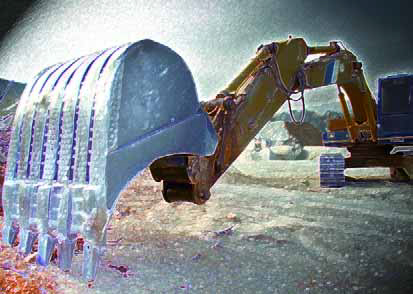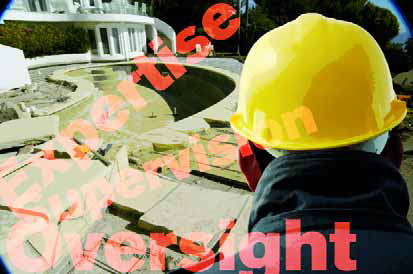project management
One would like to think that if there was anything all watershapers were good at doing, it would be digging holes. As with many other watershaping activities, however, it is apparent that some are better at it than others and that the excavation portion of a project either does a good job of setting the stage for great things to follow - or involves errors that can project themselves all the way through to the finished product. In my view, getting things right at this stage is as important as any other step in the design, engineering or construction process and is actually
In the last several of these "Details," I've covered what happens in my projects before construction begins. Now we're ready to shift gears and look at what happens on site - the place where design and execution meet. Before we look at the way I build things, however, I want to take a hard look at common practices in the field. What I write here may seem harsh, but it's not intended that way: To establish a baseline for doing things in what I would term the right way, I need to point to practices in our industry - particularly the pool/spa sector - that
In the last several of these "Details," I've covered what happens in my projects before construction begins. Now we're ready to shift gears and look at what happens on site - the place where design and execution meet. Before we look at the way I build things, however, I want to take a hard look at common practices in the field. What I write here may seem harsh, but it's not intended that way: To establish a baseline for doing things in what I would term the right way, I need to point to practices in our industry - particularly the pool/spa sector - that
In my last two columns, I've gone to unusually length in describing my views of the design-preparation and presentation processes. This time, the subjects are more compact but, in practical terms, no less significant and vital: permits and contracts. We left the discussion last time at the point where I've shown my clients the design package and it's time for them to decide what to do. In most cases, they choose to build - the usual outcome for me because of the way I pre-qualified my clients and communicate clearly with them at every step of the way. In general, if you've done the right things to this point and the project reflects an informed knowledge of what is involved in
In my last two columns, I've gone to unusually length in describing my views of the design-preparation and presentation processes. This time, the subjects are more compact but, in practical terms, no less significant and vital: permits and contracts. We left the discussion last time at the point where I've shown my clients the design package and it's time for them to decide what to do. In most cases, they choose to build - the usual outcome for me because of the way I pre-qualified my clients and communicate clearly with them at every step of the way. In general, if you've done the right things to this point and the project reflects an informed knowledge of what is involved in
The design and installation of the circulation, filtration and chemical-treatment systems for the pools at St. Lucia's Jade Mountain was a task of monumental proportions and extreme technical, physical and logistical difficulty. The effort was spearheaded by watershaper/hydraulics expert Chris Barnes, who spent months on site installing precision systems engineered to provide years of nearly maintenance-free service. Installing the circulation systems for the pools at Jade Mountain was a challenge unlike any other. I was first approached about the project by my good friend, Skip Phillips, who explained that he had already been working on the project's design for several years and indicated that it was going to be something truly amazing. He observed that the owner and his design team didn't have anyone in place with any experience with the installation of extremely complex watershapes and suggested that I might be the one to step up to the challenge and keep
I've always believed that if you're going to do something, you should do it so well that the results are beyond compare. That basic philosophy has guided our company, GCS of Woodbridge, Calif., from the very start. It has led us to apply the highest standards to every one of our projects, all of which have been executed on large estates for ambitious, affluent, selective clients who invariably want something no one else has. We've been selective from the start as well, seeking clients who are in the process of creating the homes of their dreams and who want to have fun with (and in) their exterior spaces. In most cases, what they want are true oases - resort-like settings that give them a taste of
I've always believed that if you're going to do something, you should do it so well that the results are beyond compare. That basic philosophy has guided our company, GCS of Woodbridge, Calif., from the very start. It has led us to apply the highest standards to every one of our projects, all of which have been executed on large estates for ambitious, affluent, selective clients who invariably want something no one else has. We've been selective from the start as well, seeking clients who are in the process of creating the homes of their dreams and who want to have fun with (and in) their exterior spaces. In most cases, what they want are true oases - resort-like settings that give them a taste of
If there's a constant in watershape and landscape design and construction, it's that clients are almost invariably different from one another. Through years of watching how others approach these singularities, we've seen some designers (and builders) who are so set in their ways that they limit what they're willing to provide. Indeed, there even seems to be a bias in the industry at large toward elevating those designers who have a "trademark style." In our company's case, however, repetition of styles and features is not something that gets us going: Rather, we find it much more challenging and interesting to approach each project with fresh eyes and a genuine curiosity about our clients' dreams. To that end, our approach at Verdant Custom Outdoors (San Diego, Calif.) is all about understanding our clients and avoiding any preconceptions about what we think they might want. That in mind, we deliberately approach all clients and projects with a desire to meet individualized needs - a practice that has required us to become totally adaptable when it comes to both design and construction. To be sure, this approach adds a layer of complexity to what we do in that we start from scratch with every project. Our process requires a great deal of research, but as we see it, it's always been an investment of time and resources that constantly
If there's a constant in watershape and landscape design and construction, it's that clients are almost invariably different from one another. Through years of watching how others approach these singularities, we've seen some designers (and builders) who are so set in their ways that they limit what they're willing to provide. Indeed, there even seems to be a bias in the industry at large toward elevating those designers who have a "trademark style." In our company's case, however, repetition of styles and features is not something that gets us going: Rather, we find it much more challenging and interesting to approach each project with fresh eyes and a genuine curiosity about our clients' dreams. To that end, our approach at Verdant Custom Outdoors (San Diego, Calif.) is all about understanding our clients and avoiding any preconceptions about what we think they might want. That in mind, we deliberately approach all clients and projects with a desire to meet individualized needs - a practice that has required us to become totally adaptable when it comes to both design and construction. To be sure, this approach adds a layer of complexity to what we do in that we start from scratch with every project. Our process requires a great deal of research, but as we see it, it's always been an investment of time and resources that constantly



















